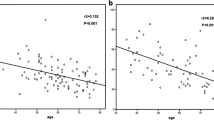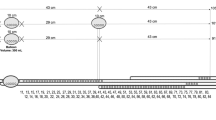Abstract
PURPOSE: This study was designed to ascertain the existence of manometric asymmetry in the anal canal in controls and in patients with fecal incontinence. METHODS: A computerized manometric technique with an eight-channel perfusion catheter was used. Coefficient of variation (CV, a mathematical expression of the degree or magnitude of deviation of a set of data points from the mean) was developed in this study as an index of anal canal manometric asymmetry. RESULTS: At 1 cm from the anal verge, mean CV was 9.3 and 8.7 percent in asymptomatic control males and females, respectively. During a maximum voluntary squeeze effort, mean CV in control males was 9.3 percent and was not significantly different (P =0.28) from that in control females (7.8 percent). In 14 consecutive female patients with fecal incontinence, mean CV at rest (1 cm from the anal verge) was 21 percent and was significantly higher (P <0.01) than in control females. Similarly, during a maximum voluntary squeeze effort, mean CV in patients with fecal incontinence was 20.5 percent and was significantly higher (P <0.01) than in the female control group (7.8 percent). CONCLUSION: It is concluded that CV, a method of expressing anal sphincter manometric asymmetry, is a useful manometric parameter in the assessment of anorectal function.
Similar content being viewed by others
References
Parks TG. The usefulness of tests in anorectal disease. World J Surg 1992;16:804–10.
Read NW, Bannister JJ. Anorectal manometry: techniques in health and anorectal disease. In: Henry MM, Swash M, eds: Coloproctology and the pelvic floor. London: Butterworths, 1985:65–87.
Coller JA. Clinical application of anorectal manometry. Gastroenterol Clin North Am 1987;16:17–33.
Perry RE, Blatchford GJ, Christensen MA, Thorson AG, Attwood SE. Manometric diagnosis of anal sphincter injuries. Am J Surg 1990;159:112–7.
Roberts PL, Coller JA, Schoetz DJ Jr, Veidenheimer MC. Manometric assessment of patients with obstetric injuries and fecal incontinence. Dis Colon Rectum 1990;33:16–20.
McHugh SM, Diamant NE. Anal canal pressure profile; a reappraisal as determined by rapid pullthrough technique. Gut 1987;28:1234–41.
Taylor BM, Beart Jr RW, Phillips SF. Longitudinal and radial variations of pressure in the human anal sphincter. Gastroenterology 1984;86:693–7.
Sakaniwa M, Sawaguchi S, Okhawa H, Ikebukuro K. Computerised analysis of anorectal manometry. Prog Pediatr Surg 1989;24:21–32.
Cali RL, Blatchford GJ, Perry RE, Pitsch RM, Thorson AG, Christensen MA. Normal variation in anorectal manometry. Dis Colon Rectum 1992;35:1161–4.
Lord PH. A new regime for the treatment of haemorrhoids. J R Soc Med 1968;61:935–6.
Hancock BD. Lord's procedure for haemorrhoids; a prospective anal pressure study. Br J Surg 1981;68:729–30.
Snooks SJ, Henry MM, Swash M. Fecal incontinence after anal dilatation. Br J Surg 1984;71:617–8.
Molloy RG, Moran KT, Coulter J, Waldron R, Kirwan WO. Mechanism of sphincter impairment following low anterior resection. Dis Colon Rectum 1992;35:462–4.
Speakman CT, Burnett SJ, Kamm MA, Bartram CI. Sphincter injury after anal dilatation demonstrated by anal endosonography. Br J Surg 1991;78:1429–30.
Deen KI, Kumar D, Williams JG, Olliff J, Keighley MR. The prevalence of anal sphincter defects in fecal incontinence; a prospective endosonic study. Gut 1993;34:685–8.
Jorge JM, Wexner SD. Etiology and management of fecal incontinence. Dis Colon Rectum 1993;36:77–97.
Sfrensen M, Tetzschner T, Rasmussen OO, Bjarnesen J, Christiansen J. Sphincter rupture in childbirth. Br J Surg 1993;80:392–4.
Snooks SJ, Setchell M, Swash M, Henry MM. Injury to innervation of pelvic floor sphincter musculature in childbirth. Lancet 1984;2:546–50.
Sultan AH, Nicholls RJ, Kamm MA, Hudson CN, Beynon J, Bartram CI. Anal endosonography and correlation within-vitro andin-vivo anatomy. Br J Surg 1993;80:508–11.
Deen KI, Kumar D, Williams JG, Olliff J, Keighley MR. Anal sphincter defects: correlation between endoanal ultrasound and surgery. Ann Surg 1993;218:201–5.
Dreznik Z, Fleshman JW, Kodner IJ, Fry RD. Restoration of squeeze pressure with sphincter repair to achieve continence [meeting abstract]. Dis Colon Rectum 1990;33:P22.
Blatchford GJ, Perry RE, Christensen MA, Thorson AG. The effect of sphincteroplasty on manometric vector symmetry [meeting abstract]. Dis Colon Rectum 1990;33:P22.
Author information
Authors and Affiliations
About this article
Cite this article
Williams, N., Barlow, J., Hobson, A. et al. Manometric asymmetry in the anal canal in controls and patients with fecal incontinence. Dis Colon Rectum 38, 1275–1280 (1995). https://doi.org/10.1007/BF02049152
Issue Date:
DOI: https://doi.org/10.1007/BF02049152




